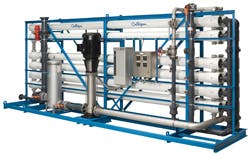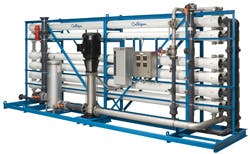Water Reuse Solution Helps Beverage Plant Meet Sustainability Goals, Save Costs
Water is an essential ingredient in industrial production. In some cases, it is critical for the production process itself (i.e., process water). For the food and beverage industry in particular, water is a crucial element in the actual product.
Food and beverage companies often require water that is similar to drinking water -- albeit with some differences. The water must be consistent and reliable, regardless of where in the world they use it. Therefore, initially getting the right quality of water is critical. Further, the quality of water drives the quality of many processes, particularly how energy is used in a plant: Better quality water typically leads to better efficiency of energy use.
Food and beverage manufacturers also need to balance energy and efficiency with their water use. A growing area of importance is reclamation and reuse -- utilizing water treatment solutions that enable manufacturers to take water from various parts of the production process and treat it so that it can be reused efficiently. This emphasis on reuse helps reduce demand on municipal water supplies or other source water, thus enhancing sustainability while also increasing efficiencies and reducing costs.
Culligan Matrix Solutions®, the commercial and industrial division of Culligan International, worked with a major beverage producer in Texas on such a project. One of the manufacturer's large beverage plants sought to reduce the impact of its operations on the environment while meeting the water treatment challenges at its facility. Its sustainability goals included reducing the water-to-use ratio associated with its operations.
This facility was using city water in its utility and plant processes. The company also had its own wastewater treatment plant that treated the plant's wastewater and discharged it to a local municipality. The inlet municipal water was used for a variety of functions in the facility including process water, boiler make-up, cooling tower make-up, and clean-in-place (CIP) make-up.
The Discovery Process
Conducting a structured discovery process was one of the first and most important steps in determining a solution. A Culligan sales engineer surveyed the facility, obtained a series of water samples, reviewed water balance plans and effluent quality at each waste discharge point within the plant, and assessed wastewater treatment costs. Culligan's application engineering and field sales teams performed reverse osmosis (RO) projections, evaluated water balance scenarios and calculated resulting energy and water savings to determine a viable approach for the plant.
"We really like to work directly with the end user, the people who understand not just the water but its role in the entire process," said Ed Orvidas, Director Industrial Strategic Accounts, Culligan Matrix Solutions. "We work with the operations team and the facilities team to really understand all parts of their process -- where they use water and how it fits into the operations. From there, we develop a solution that balances water needs, energy needs and the facility's needs -- the best overall solution to meet their goals."
After the plant walk-through, the team identified several areas for improvement and water savings. Examples included:
- Adjusting existing water equipment to operate at design parameters. The site walk-through found that one of the two existing nanofilters was operating at lower operating recoveries, sending excess water to drain.
- Repairs and adjustments to valves. The walk-through revealed leaking solenoid valves on two of the carbon units, causing additional water loss to drain. Repairs to the solenoid valves and valve adjustments to the RO were made, saving the plant 80 gpm of wasted water, or 115,200 gallons of water per day, translating into a savings of 42,048,000 gallons per year.
- Improving water quality to enhance plant boiler performance, reduce boiler blowdown and save energy.
- Using a reclaim RO system to treat and reuse the reject from the two process water nanofiltration systems.
- Optimizing and reclaiming plant CIP process wastewater.
- Using collected nanofiltration system wastewater to backwash existing greensand filters.
- Reviewing plant cooling tower cycles and determining if substantial improvements could be made to tower blowdown.
- Adding flow controls and/or collecting instrumentation side-stream water to reduce or reclaim the water going to drain.
The next step was to sit down with the plant personnel, collect cost information and understand other conservation projects that were underway. A chart was developed from this information, listing the yearly water savings, any additional equipment and installation costs required for the modification, and an estimated ROI for each project. This table provided data that enabled the plant to make a good business decision on what projects they would like to move forward with.
Before finalizing plans, the company decided to validate the initial site information by working with Culligan and its contracted engineering firm to develop a plant water balance, collect process water use data and confirm plant savings.
The Solution
After the team analyzed this data, a decision was made to devise a solution that would reclaim the reject water from the existing plant process water nanofiltration units and allow it to be reused as utility or inlet feedwater. Culligan created a scheme that included a reject recovery tank and brine reclaim RO, a storage tank, level controls, and a repressurization pump skid. The existing chemical feed system was used to adjust the RO brine waste chemistry. The chemical feed system helps reduce scaling and fouling, and thus promotes efficient performance of the newly-added brine reclaim RO.
The second component of the solution was a Culligan G3 RO model designed specifically for treating RO brine wastewater. The compact, skid-mounted G3 unit offered a high level of flexibility during installation in terms of location and space requirements.
The third component was the brine reclaim RO product water storage tank with level controls and repressurization pumps to feed the boiler. All of these solutions were integrated into the plant's existing water system data control network.
Results
The economic and water-use impact of this solution was quickly approved, and capital funds were released for this project. By all measures, the strategy has proven to be highly successful.
Once the equipment was installed and operational, the plant's overall water-to-use ratio was reduced by approximately 20 percent, from 3.1 down to 2.5. This exceeded its water-use savings sustainability goal for the year.
Initially, the nanofiltration units combined produced up to 550 gpm of product water while producing a combined 185 gpm of reject water. After the new system was installed, the concentrated reject water was reduced by more than half to just 85 gpm, saving 100 gpm of wastewater.
In addition, the two plant nanofiltration systems operate at an average 50 percent utilization rate. This resulted in saving approximately 26 million gallons of water per year that no longer went to the facility's wastewater plant for treatment.
Measured in terms of dollars, the solution eliminated the need -- and the cost -- to purchase this quantity of water and then treat it as a wastewater. The estimated dollar savings was approximately $244,000 per year. This alone provided a high return on investment, as the cost of the equipment, installation and site preparation resulted in less than a two-year payback.
"Food and beverage is probably the industry that pays the greatest attention to its water footprint. For example, how much water am I using to make a given amount of product?" said Orvidas. "There is a huge pressure in the industry to get that use down. That's one reason that the food and beverage industry in many ways sets the standard for reuse and reclamation."
About the Company: Culligan Matrix Solutions is the Commercial and Industrial division of Culligan International Company, a leading global innovator of advanced water softening and filtration solutions for more than 75 years. For more information visit www.culliganmatrixsolutions.com.



